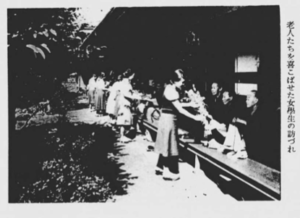Foucault’s The Birth of Clinic and Discipline and Punish triggered criticism and reflection on the institutions such as hospitals and mental asylum. The architectural design and administrative formats in these places were criticized for restricting and stripping the basic dignity of human beings. It is a similar case for nursing homes.
The history of the nursing home can be traced to the construction of poorhouses in England in the seventeenth century. It was specifically designed to contain and care for the marginal social collectives since, at that time, hospitals started to exclude the obstetrical, indigent, and insane patient, as well as lepers and children.1 Nursing homes originated from hospitals, which explains why their later construction and design adopted the structure of hospitals. The position of nursing homes in society is similar to hospitals as well. According to Roger Luckhurst’s chapter on prison, asylum and hospital in his work on Corridors, these places possess the characteristic of alienation, isolating from the social and familial environment.2 However, nursing homes in Japan in the pre-war time showed opposite attributes. They tended to recreate the domestic space for the aged through architectural construction and the arrangement of daily activities. In my long essay, I plan to focus on this unique characteristic of the nursing home in Japan.
The motivation for developing social institutions in Japan was similar to that of other Western countries (which is to take care of the life of the elderly), but the existence of nursing homes could be viewed as an exceptionally unusual case in East Asian countries which respected Confucianism as the dominant guideline for social behaviour and hierarchy. Taking care of the elders and seniors is the responsibility of the younger generations in a family. In Mika Toba’s report on the biographies of residents in a nursing home in pre-war Japan, we could know that most of them were people who either did not have a child or lost their child before coming to old age. This sometimes even became a condition for the people who wanted to apply for residence in a nursing home. The Tokyo nursing home, which I mainly focused on, had a hut called “Family hut” (家庭寮). It was explicitly built for elderly people who still had family members of the same generation to live together. The set-up of the rooms in the family hut was intentionally designed in the same way as typical Japanese houses, “the structure of the hut only changes a little compared to a normal house. At the middle of the tatami room, there is a hibachi”.3 Not only was the physical construction made to be more similar to a traditional Japanese house, but the timetable arrangement also contained the intention to recreate everyday life regardless of following the concept of ‘nursing home’. Most of the hours in a day were designated to devote to housework. The timetable of the nursing home also aimed to give the aged as much freedom as possible. As long as the residents do not have a serious health issue, they have the freedom to go out.

Figure 1: the residents in the Tokyo nursing home receiving gifts from female students (caption on the left side: the visit of the female students delights elderly people)
Unlike the alienating nature of the hospital and mental asylum, the nursing home in Japan was closely connected with society. The Tokyo nursing home held regular visiting activities. In its anniversary book, there is a picture (figure 1) showing young students sending elderly people gifts. The arrangement of student visiting could be seen as compensation for the childless life of those elderly people. Since a Confucianist society operates on family units, these childless old people were seen as the social marginals included in the relief law enacted in 1932. The Japanese welfare system was established based on a family-like society. Nursing homes did not merely operate as shelters or medical supporting institutions for the elderly people in need, but instead as substitutions of a family for them.
Examining the domesticity in nursing homes on a broader scale, the development of the nursing home in Japan also marked the attempt of contemporary Japanese to explore an alternative way of Asian modernization instead of following the trajectory of the West. The first nursing home established in Japan was called St. Hilda nursing home and was operated by a Christian group in Japan. After the promotion of the Meiji emperor to support the people who needed social welfare in 1868, the number of nursing homes increased, and many of them were run by local religious groups, especially Pure Land Buddhism. The process of making the nursing home more like a domestic space reflects the attempt to seek an alternative path for the modernization of Japan on a social and domestic level. There is a relationship between the construction of the nursing home and the building of a modern Asian society based on the tenet of benevolence and Confucianism. Just like Jordan Sand argues that there was the dissolution of tradition and emphasis on domestic life, and the occurrence of this turn of dwelling and domestic spaces in the late Meiji and early Taisho period when Japan fully participated in global imperial competition was not just a coincidence.4
- Renée Rose Shield, Uneasy Endings: Daily Life in an American Nursing Home, Uneasy Endings (Cornell University Press, 2018), p.30-31. [↩]
- Roger Luckhurst, Corridors : Passages of Modernity (London: Reaktion Books, 2019), p.190. [↩]
- 東京養老院, ‘養老 : 東京養老院概要’ (東京養老院, 1938), p.76-77. [↩]
- Jordan Sand, House and Home in Modern Japan: Reforming Everyday Life 1880-1930 (Cambridge, Mass.; London: Harvard University Press, 2005), p. 4-5. [↩]